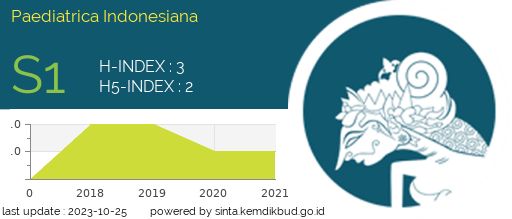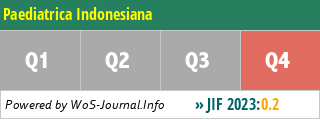Neonates with epidermolysis bullosa simplex: a case series
Keywords:
epidermolysis bullosa simplex, neonatesAbstract
Epidermolysis bullosa is a rare and currently incurable inherited disorders characterized by mechanical fragility of affected tissues which can be fatal. We describe two cases of neonatal Epidermolisis bullosa followed in the high risk neonates ward. The first case presented with bulla at one day after birth with amniotic band syndrome and the second case presented with bulla right after birth with neonatal infection.
Keyword: epidermolysis bullosa simplex, neonates
References
Fine JD. Epidemiology of inherited epidermolysis bullosa based on incidence and prevalence estimates from the national epidermolysis Bullosa registry. JAMA Dermatology. 2016; 152: 1231–8. DOI: https://doi.org/10.1001/jamadermatol.2016.2473
Bardhan A, Bruckner-Tuderman L, Chapple ILC, Fine JD, Harper N, Has C, et al. Epidermolysis bullosa. Nat Rev Dis Prim. 2020; 6: 1–27. DOI: https://doi.org/10.1038/s41572-020-0210-0.
Gonzalez ME. Evaluation and treatment of the newborn with epidermolysis bullosa. Semin Perinatol. 2013; 37: 32–9. DOI: https://doi.org/10.1053/j.semperi.2012.11.004
Intong LRA, Murrell DF. Inherited epidermolysis bullosa: New diagnostic criteria and classification. Clin Dermatol. 2012; 30: 70–7. DOI: https://doi.org/10.1016/j.clindermatol.2011.03.012
Fine JD, Bruckner-Tuderman L, Eady RAJ, Bauer EA, Bauer JW, Has C, et al. Inherited epidermolysis bullosa: Updated recommendations on diagnosis and classification. J Am Acad Dermatol. 2014;70:1103–26. DOI: https://doi.org/10.1016/j.jaad.2014.01.903
Aumailley M, Has C, Tunggal L, Bruckner-Tuderman L. Molecular basis of inherited skin-blistering disorders, and therapeutic implications. Expert Rev Mol Med. 2006; 8: 1–21. DOI: https://doi.org/10.1017/S1462399406000123
Coulombe PA, Kerns ML, Fuchs E. Epidermolysis bullosa simplex: A paradigm for disorders of tissue fragility. J Clin Invest. 2009; 119: 1784–93. DOI: https://doi.org/10.1172/JCI38177
El Hachem M, Zambruno G, Bourdon-Lanoy E, Ciasulli A, Buisson C, Hadj-Rabia S, et al. Multicentre consensus recommendations for skin care in inherited epidermolysis bullosa. Orphanet J Rare Dis. 2014;9:1–20. DOI: https://doi.org/10.1186/1750-1172-9-76
Snadecki H, Criscione V, Jaquith A, Hay B, Deng A, Wiss K. Dystrophic epidermolysis bullosa associated with amniotic band syndrome. Pediatr Dermatol. 2014;31:212–6. DOI: https://doi.org/10.1111/pde.12285
Katorza E, Weisz B, Sevillia J, Mazkereth R, Barzilai A, Achiron R. Unusual prenatal sonographic findings of epidermolysis bullosa mimicking an amniotic band constriction ring. J Ultrasound Med. 2009;28:73–5. DOI: https://doi.org/10.7863/jum.2009.28.1.73
Ockleford CD, McCracken SA, Rimmington LA, Hubbard ARD, Bright NA, Cockcroft N, et al. Type VII collagen associated with the basement membrane of amniotic epithelium forms giant anchoring rivets which penetrate a massive lamina reticularis. Placenta. 2013;34:727–37. DOI: https://doi.org/10.1016/j.placenta.2013.06.002
Schultz B, Hook K. Bullous Diseases in Children: A Review of Clinical Features and Treatment Options. Pediatr Drugs. 2019;21:345–56. DOI: https://doi.org/10.1007/s40272-019-00349-3
Van Der Kooi-Pol MM, De Vogel CP, Westerhout-Pluister GN, Veenstra-Kyuchukova YK, Duipmans JC, Glasner C, et al. High anti-staphylococcal antibody titers in patients with epidermolysis bullosa relate to long-term colonization with alternating types of staphylococcus aureus. J Invest Dermatol. 2013;133:847–50. DOI: https://doi.org/10.1038/jid.2012.347
Fine JD, Johnson LB, Weiner M, Suchindran C. Gastrointestinal complications of inherited epidermolysis bullosa: Cumulative experience of the national epidermolysis bullosa registry. J Pediatr Gastroenterol Nutr. 2008;46:147–58. DOI: https://doi.org/10.1097/MPG.0b013e31812f5667
Bolling MC, Lemmink HH, Jansen GHL, Jonkman MF. Mutations in KRT5 and KRT14 cause epidermolysis bullosa simplex in 75% of the patients. Br J Dermatol. 2011;164:637–44. DOI: https://doi.org/10.1111/j.1365-2133.2010.10146.x
Wakiguchi H, Hasegawa S, Maeba S, Kimura S, Ito S, Tateishi H, et al. A Sporadic Neonatal Case of Epidermolysis Bullosa Simplex Generalized Intermediate with KRT5 and KRT14 Gene Mutations. Am J Perinatol Reports. 2016;06:e108–e111. PMID: 26929861
Downloads
Published
How to Cite
Issue
Section
License
Copyright (c) 2025 FITRI AMALIA, WISTIANI WISTIANI, MEIRA DEWI KUSUMA ASTUTI, YOSEP FERDINAND RAHMAT

This work is licensed under a Creative Commons Attribution-NonCommercial-ShareAlike 4.0 International License.
Authors who publish with this journal agree to the following terms:
Authors retain copyright and grant the journal right of first publication with the work simultaneously licensed under a Creative Commons Attribution License that allows others to share the work with an acknowledgement of the work's authorship and initial publication in this journal.
Authors are able to enter into separate, additional contractual arrangements for the non-exclusive distribution of the journal's published version of the work (e.g., post it to an institutional repository or publish it in a book), with an acknowledgement of its initial publication in this journal.
Accepted 2025-04-22
Published 2025-04-25













